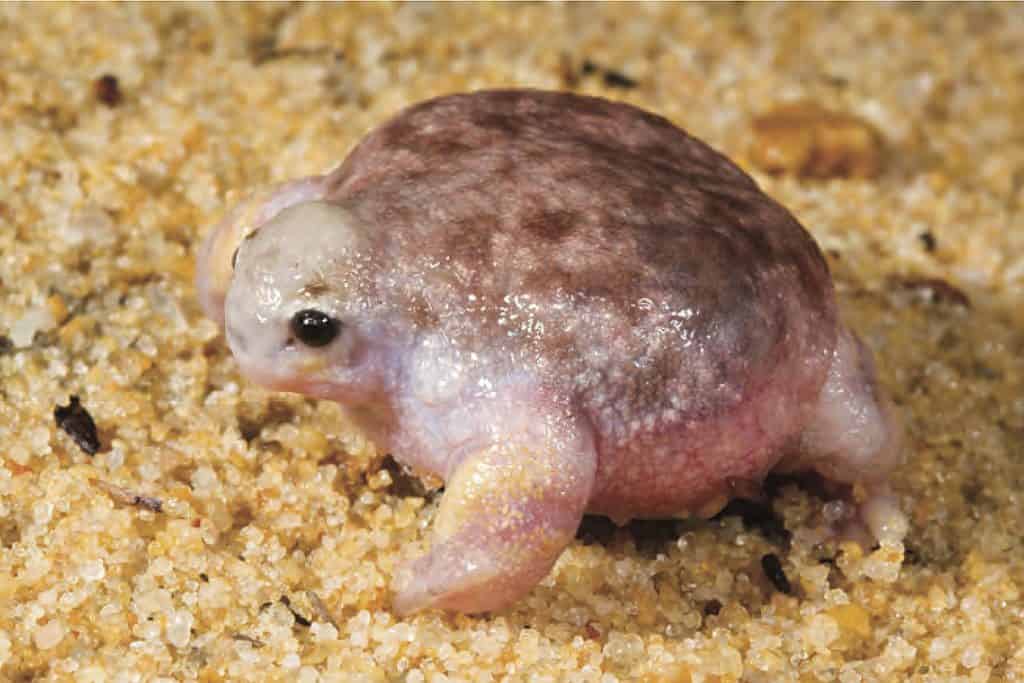A turtle frog can eat more than 400 termites in a single meal.
Advertisement
Turtle Frog Scientific Classification
- Kingdom
- Animalia
- Phylum
- Chordata
- Class
- Amphibia
- Order
- Anura
- Family
- Myobatrachidae
- Genus
- Myobatrachus
- Scientific Name
- Myobatrachus gouldii
Read our Complete Guide to Classification of Animals.
Turtle Frog Conservation Status
Turtle Frog Facts
- Prey
- Termites
- Main Prey
- Termites
- Name Of Young
- Froglets
- Group Behavior
- Solitary
- Solitary except during mating season
- Fun Fact
- A turtle frog can eat more than 400 termites in a single meal.
- Most Distinctive Feature
- Strong forearms and blob shape
- Incubation Period
- 2 months
- Litter Size
- 50 eggs
- Habitat
- Arid, Australian desert
- Predators
- Larger frogs, snakes, birds of prey
- Diet
- Insectivore
- Lifestyle
- Nocturnal
- Origin
- Perth, Australia
- Average Clutch Size
- 25
View all of the Turtle Frog images!
The turtle frog is a fascinating specimen, with a body shaped like a turtle missing its shell. These animals have small beady eyes and fleshy pink skin and are often described as a “blob” shape. The frogs bear powerful front limbs, making them well-equipped to burrow underground and forage for termites, their favorite food. They emerge from underground only to mate following Southwest Australia’s mating season. Read on to learn more about these intriguing amphibians.
5 Incredible Turtle Frog Facts!
- Rather than burrowing with their hind legs, these animals uses their muscular front legs to claw headfirst into sand. They’ll keep burrowing until they reach about three feet below the surface.
- Males call out to females for up to four months during the mating season.
- Turtle frogs are nocturnal, avoiding the scorching Australian sun during the day.
- To survive in highly arid environments, turtle frogs bury their eggs in moist sand far below the surface instead of water.
- The turtle frog exclusively eats termites and often makes its home near termite hills.
Turtle Frog Scientific Name
The scientific name is Myobatrachus gouldii, after famous illustrator and ornithologist John Gould. It is a part of the myobatrachidae family of frogs found in New Guinea and Australia. There is only one species, and scientists believe it to have specially adapted to southwestern Australia’s arid desert climate.
Turtle Frog Appearance

The turtle frog exclusively eats termites and often makes its home near termite hills.
©1,570 × 1,049 pixels, file size: 1.95 MB, MIME type: image/png – License
This variety of frogs is one of the most distinct-looking specimens out there. The turtle frog features bright pink skin with gold and black flecked throughout to blend into their surroundings. Their tiny small eyes and wide mouth are well-suited to munching on delicious termites. They have blunt noses, stumpy legs, and powerful forearms, almost appearing like a turtle missing its shell. At the end of each forearm lies a set of claws, which help turtle frogs dig for food and burrow into their holes underground, where they make their homes. In size, turtle frogs grow to approximately 2 inches.
Turtle Frog Behavior
These subterranean creatures spend almost their entire lifespan entirely underground, burrowing for shelter and food sources. Each individual makes its home near termite colonies, where it can feed on rogue stragglers it encounters. These frogs only emerge from their burrows during the mating season, shortly after seasonal rains in Perth.
Habitat
The turtle frog makes its home in Perth in Western Australia, with a territorial range stretching from Geraldton to the Fitzgerald River. In Perth, they are common in the coastal plains but notably absent from more mountainous regions like the Darling Range.
These stout amphibians live in underground burrows, nestled in sandy dirt wherever termites are found.
Diet
These amphibians’ diets consist entirely of termites, their sole and favorite food source. In fact, turtle frogs can eat approximately 400 termites in a single meal. These frogs make their homes directly adjacent to termite colonies for easy access to meals.
Predators & Threats
What Eats Turtle Frogs?
These amphibians benefit from their underground burrows to protect their skin from the scorching Australian desert sun and hide from predators. Hiding more than three feet below the earth’s surface protects them from larger frogs, snakes, or overhead birds of prey.
Turtle Frog Reproduction, Babies, and Lifespan
Mating season begins after the seasonal rains in Perth, usually in the early summer, though turtle frogs have been observed in July. Males crawl up their burrows, moving closer to the surface, to call out to a female partner with a distinct, deep croak.
Once two frogs find each other, they burrow down more than three feet below the surface. However, the breeding process actually begins late in the summer, up to four months after the frogs meet. This is because of the unique reproduction system that turtle frogs have developed.
A female will lay her eggs in the late summer – up to 50 at a time – which take around two months to develop and hatch. Unlike typical amphibians, however, their young emerges from their eggs as fully formed, tiny froglets – skipping the tadpole phase altogether. The hatching must align with the next rainy season, so the froglets don’t dehydrate. Once the spring rains reappear, these babies can leave the safety of their burrows to find their own mates.
In the wild, they live for four to six years.
Population
While there are no detailed population counts, they have an “of least concern” conservation status. They exclusively live in Southwestern Australia.
Up Next
View all 133 animals that start with TTurtle Frog FAQs (Frequently Asked Questions)
What exactly is a turtle frog?
The turtle frog is a fascinating specimen, with a body shaped like a turtle missing its shell. These animals have small beady eyes and fleshy pink skin and are often described as a “blob” shape.
What do turtle frogs eat?
These frogs exclusively feast on termites and have specially adapted front arms, small eyes, and wide mouths that make them excellent termite foragers.
Are turtle frogs extinct?
Far from it – they are an animal of most minor concern on the conservation list. While they only live in one region of Australia, there’s a sizable population of frogs.
Thank you for reading! Have some feedback for us? Contact the AZ Animals editorial team.
Sources
- American Museum of Natural History, Available here: https://amphibiansoftheworld.amnh.org/Amphibia/Anura/Myobatrachoidea/Myobatrachidae
- Western Australian Museum, Available here: https://museum.wa.gov.au/explore/frogwatch/frogs/turtle-frog
- Australian Geographic, Available here: https://www.australiangeographic.com.au/blogs/creatura-blog/2014/12/turtle-frog-burrows-head-first/
- National Library of Medicine, Available here: https://www.ncbi.nlm.nih.gov/pmc/articles/PMC5351994/

















